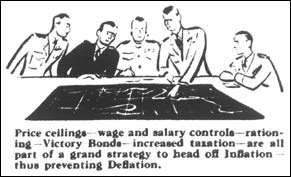Throughout the war years, numerous articles appeared in the press to justify the need for controls. Citizens were reminded of the sharp rise in inflation during the First World War that eventually led to the depression years of the 1930s. Various ads appealed to the patriotic duty of Canadians to put up with government intervention in order to ensure there was a stable economy at the end of the war.
Part of the program of the WPTB was the introduction of price ceilings using a 27-day stretch as a base period. No price for a good or service was to exceed the level that was in effect between 15 September and 11 October 1941. The Board was given the power to vary any maximum price and to add or change conditions of regulation. In addition to price fixing of goods, eleven services were regulated.
 Another component of the controls was the licensing of businesses. It was announced in October that any person or firm manufacturing, handling, or dealing in food, feed, livestock, poultry, yarn, cloth, clothing or footwear was required to acquire a licence by 1 December 1941. The first certificate issued to each licensee was to be displayed in a window and was in effect from 1 December until 31 March 1942.
Another component of the controls was the licensing of businesses. It was announced in October that any person or firm manufacturing, handling, or dealing in food, feed, livestock, poultry, yarn, cloth, clothing or footwear was required to acquire a licence by 1 December 1941. The first certificate issued to each licensee was to be displayed in a window and was in effect from 1 December until 31 March 1942. Right from the outset Canadian women were called upon to be guardians of the price law. The Consumer Branch of the Prices Board issued small blue-coloured booklets titled "My Price Ceiling Book" in which prices could be noted and compared. In June 1943 the "Little Blue Book," as it became known, was revised and improved. Women could acquire them from local Board offices. They were encouraged to report any price violations and were assured of confidentiality.
By mid-1942 infractions were regularly reported in newspapers across the country. Locally, one of the first fines was issued in June 1943 to individuals hoarding molasses. As time went on, there were more and more infractions, reported in a weekly account. In November 1943, the WPTB fined a local man $100 for "accumulating supplies of sugar beyond his needs." In 2004 that amount, according the Bank of Canada inflation calculator, would equal $1,171.96.
Large notices appeared in the press with titles such as "Loyal Citizens Do Not Hoard," "The Hoarder - Public Enemy No.1", and "Cupboard Quisling." According to the WPTB a hoarder was "any person who buys anything beyond his immediate needs."
In reaction to the controls, some people tried to get scarce or desired goods from the black market that came into existence. The government ran ads about the consequences of acquiring items illegally and strongly encouraged consumers to beware.
The enforcement of the regulations in Summerside was at first handled from the PEI regional office in Charlottetown. There were thirteen regions across Canada. Summerside native Ewen Nicholson was appointed the Prices Supply representative for the Island in August 1943, succeeding George Barbour.
By May of 1944 a representative was appointed for Summerside. Roland Phillipson, who had returned from overseas after serving with the Canadian Forestry Corps, became the investigator for this district. He and his stenographer Mary Barriault had an office on the second floor of the Post Office building.
During the existence of the WPTB there were many questions asked by the general public. In order to assist consumers to make the right decisions, the Board prepared a regular column for press release called "Questions and Answers." It ran in local newspapers on a regular basis from June 1942 until after the war.
The national Board made a continual effort to extol the benefits of price control and a stable economy. One of the series it produced in 1944 was called "About the Things You Buy in Wartime" and covered such topics as shoes, milk, and children's underwear. Another series in 1944 appeared under the title "Good News on the War Fronts Must Not Be Allowed to Lessen Our Efforts on the Home Front."
In May 1945, Ottawa announced the gradual removal of controls in preparation for the conversion from a war to a peace economy. However, in August a press release indicated that price ceilings, rationing, and production controls would be continued. Finance Minister Isley made special mention of textiles, meat, and building materials. In the immediate post-war economy citizens were urged to continue to watch prices, curtail the urge to buy and thus prevent inflation.
The Wartime Prices and Trade Board was divided into wholesale and retail sections in 1945. It eventually was disbanded in 1951.
| Related Articles | Related Images | Related Memories | Related Websites | Inflation Calculator |
| Home Page | Site Map | Contact Us | Wyatt Heritage Properties |











